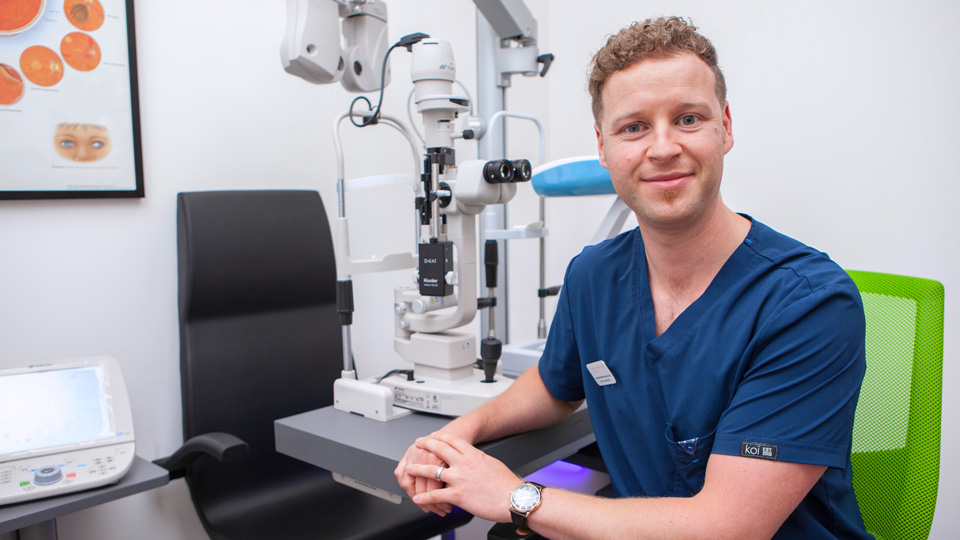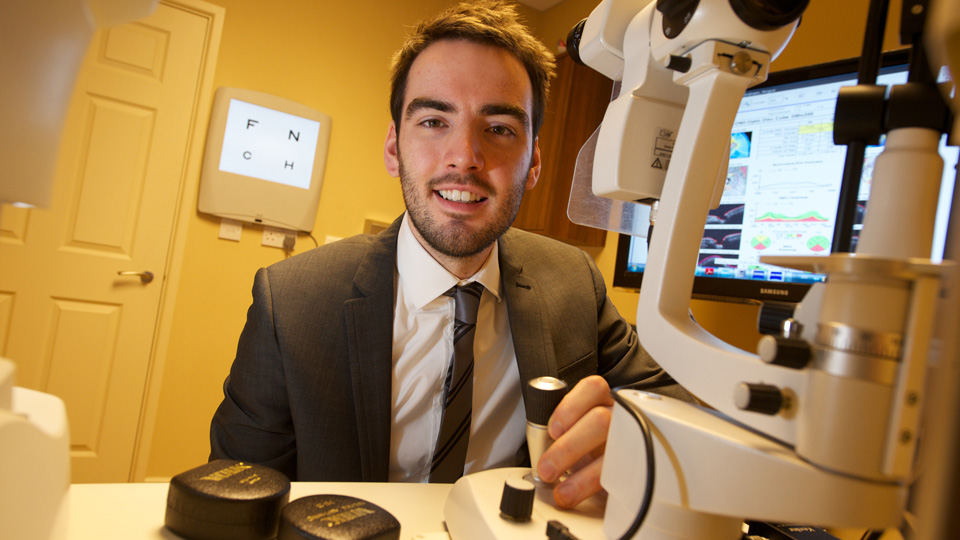- OT
- Life in practice
- Practitioner stories
- Specialty lenses in focus
Contact lens guide
Specialty lenses in focus
OT speaks with optometrists about how a collaborative approach can support a patient’s journey into specialty contact lenses

07 December 2023
There is a unique type of problem solving that optometrist, Cian Gildea, engages with in fitting patients with specialty contact lenses.
Although he deals with contact lenses on a daily basis, it still surprises Gildea how much this miniature device – smaller than the world’s tiniest snow globe – can change people’s lives.
“It’s amazing to think what these contact lenses can do to improve a person’s life. There is an enormous sense of fulfilment being able to make such a difference for a person,” he shared.
Memorable moments
Gildea, who works in private practice and for a public hospital in Dublin, recalls a patient who lived alone and was struggling with basic tasks.His best corrected visual acuity (BCVA) was 6/36. The patient was monocular, with limbal stem cell deficiency and a corneal diameter of 11mm. An ocular pemphigoid meant his fornices were shortened and this created challenges for scleral lens fitting.
“We used a low modulus hydrogel lens coupled with a rigid gas permeable corneal lens to achieve a BCVA of 6/12. We were all delighted with the result,” Gildea shared.

On another occasion a woman with chronic dry eye disease, neurotrophic keratitis and ulcers was referred for a scleral lens assessment.
“Her life was being severely affected by her ocular condition. She was unable to work, drive or enjoy any of her usual activities,” Gildea recalled. He added that alongside the patient’s visual challenges, her self-confidence had been affected.
“Simple things like going to the shops was an issue,” he shared.
Her BCVA wearing spectacles was 6/36 in the right eye and 6/18 in the left eye.
Gildea and his team were able to achieve a “great fit” using a notch on each scleral lens to avoid large pinguecula.
He shared that not only was the patient able to drive and enjoy activities again, having achieved a BCVA of 6/12 in the right and 6/9 in the left, but her vision continued to improve over time. “The lenses allowed the corneal surface to heal and BCVA came up to 6/6 in each eye,” Gildea said.
Varied workload
Gildea fits a large range of lenses working in practice – from post-graft corneal lenses, to scleral lenses for ocular surface disease and orthokeratology for myopia management.The lens that he fits will depend on the needs of the patient and the condition he is trying to manage.
“If a patient, for instance, has high levels of ametropia, I would consider a corneal gas permeable lens. If they have high degrees of refractive astigmatism that fall outside the conventional soft parameter range, a back surface toric or bitoric corneal lens is a good option,” Gildea shared.
If a patient is struggling with comfort using a keratoconic corneal lens, or there are challenges getting a corneal lens to centre, Gildea will use a piggyback system – where a gas permeable lens is fitted on top of a soft contact lens. “I think this is overlooked and a great problem-solving tool to have in the armoury,” he shared.
Gildea added that scleral lenses are another important tool to deploy for both normal and irregular cornea patients.
“These lenses have made a resurgence and modern designs and materials have made huge improvements to this lens modality,” Gildea emphasised.
Solving such visual problems with contact lenses can have a profound effect on the patient’s life both at work and at home, massively enhancing their confidence and general wellbeing
When it comes to soft contact lenses, Gildea shared that some companies offer extended or fully customisable parameter ranges.
He advised practitioners to pay attention to the horizontal visible iris diameter when conducting a soft lens fit.
“Knowing the sagittal height of an eye and matching it to the most appropriate sagittal depth of a lens can make all the difference in fitting a soft lens,” Gildea said.
Gildea shared that the administration team, nurses and technicians all have an important role to play in the specialty contact lens journey.
“Each member of the team is integral,” he emphasised.
The administration team are responsible for booking appointments and answering patient queries. “Using their communication skills is key to making sure things run as smoothly as possible,” Gildea shared.
Team effort
Nurses and technicians are responsible for carrying out patient images and scans, and carrying out contact lens teaches.“Getting a good scan can be crucial when fitting and designing specialist lenses as well as monitoring potential disease progression. Having really high standards in this area is so important,” Gildea said.
Carrying out application and removal training is also key, he added. Gildea shared that if a patient cannot master this part of the pathway, it may be the end of their specialist lens journey.
“The nurse and technicians apply all their skill and expertise with empathy, compassion and perseverance to achieve successful outcomes for the large majority of patients,” he said.
A profound effect
Optometrist and director, Craig McArthur fits a range of specialty contact lenses at Peter Ivins Eyecare in Bearsden.
Many of the patients who are fitted with specialty contact lenses cannot achieve the same level of visual function through spectacles, due to conditions that affect their cornea.
“Solving such visual problems with contact lenses can have a profound effect on the patient’s life both at work and at home, massively enhancing their confidence and general wellbeing,” he said.

McArthur shared that the practice team conduct baseline measurements for speciality lenses and assist with the handling and care teaching session. They also keep in contact with patients over the first few months of contact lens wear through the practice’s contact lens buddy system.
“Like all contact lens fitting in our practice, a collaborative approach from the wider practice team is crucial,” he emphasised.
“The entire team needs to be trained and knowledgeable in speciality lenses to answer questions patient may have.”



Comments (0)
You must be logged in to join the discussion. Log in